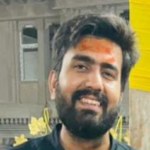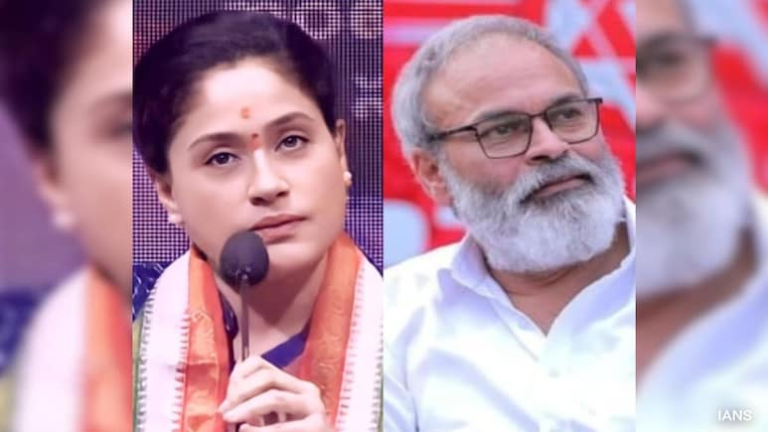
“ Muskuraiye, aap Lucknow mein hain” (smile you’re in Lucknow) goes the famous adage in the Uttar Pradesh capital. But it’s the city’s cricketing ecosystem that is beaming after the Bharat Ratna Shri Atal Bihari Vajpayee Ekana Stadium, known better as the Ekana Stadium, was added to the venue roster for the 2023 ICC ODI World Cup.
The venue, inaugurated in 2017, serves as the home ground for the Indian Premier League franchise Lucknow Super Giants (LSG) and is also a preferred venue for international women’s cricket. Furthermore, it has been the adopted home ground for Afghanistan’s men’s team for its international fixtures.
“We looked at the infrastructure in Kanpur too before this stadium and complex was constructed and the idea was to ensure whatever was lacking there was sorted out here,” Uday Sinha, director of Ekana Sportz City Private Limited, says. “We looked at concerns spectators had there, like elevator access, view from the stands, etc, and wanted Ekana to be an improvement on all those fronts. We had the opportunity to channel the best of what stadiums around the country have,” he adds.
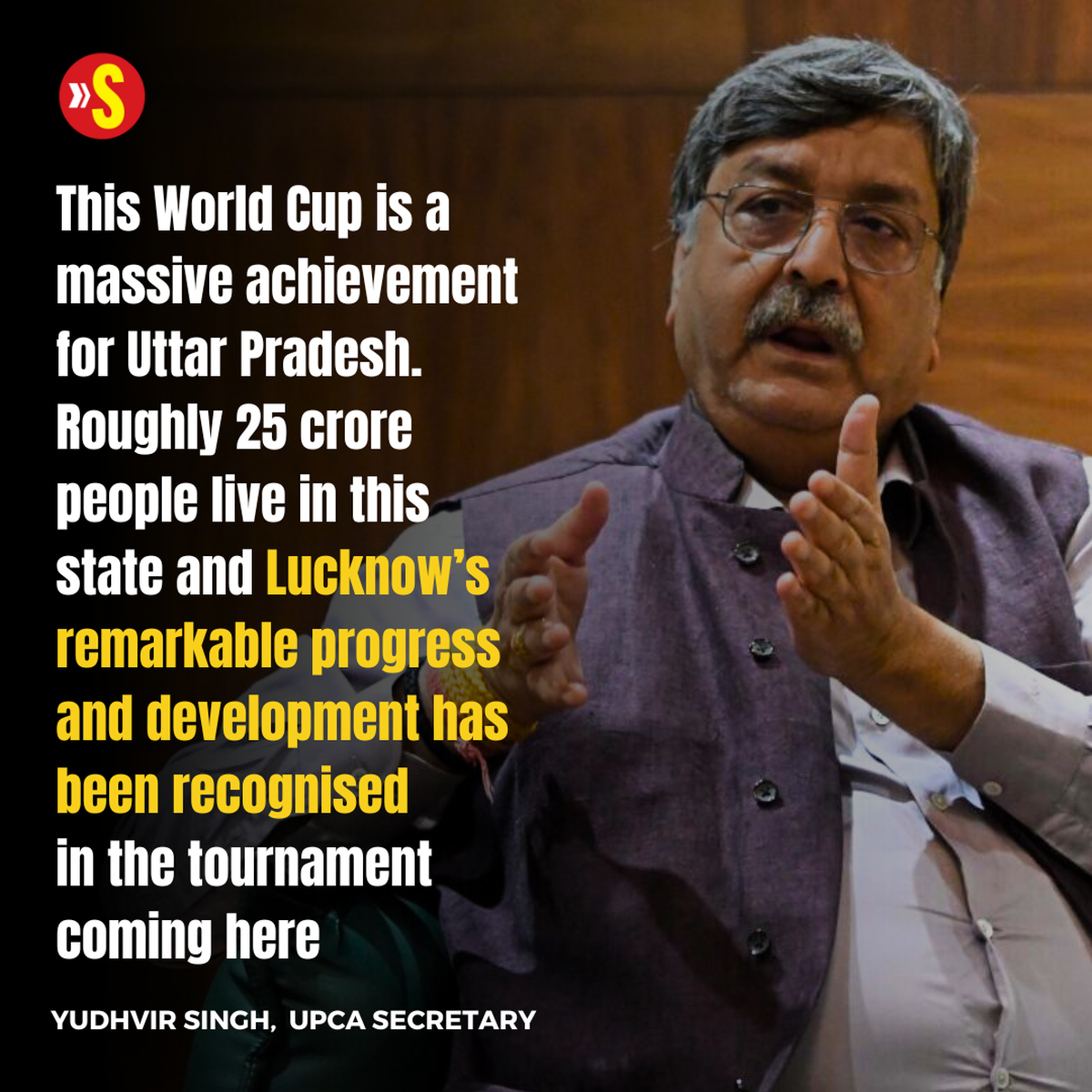
“Watching World Cup matches will be a big boost to the cricket scene here and inspire young kids to stick with the game. We can assure you that we will come through as the premises that hosts this World Cup the best,” Yudhvir Singh, Uttar Pradesh Cricket Association secretary, adds.
If you are planning to watch a game at the Ekana Stadium during the World Cup, here’s all you need to know:
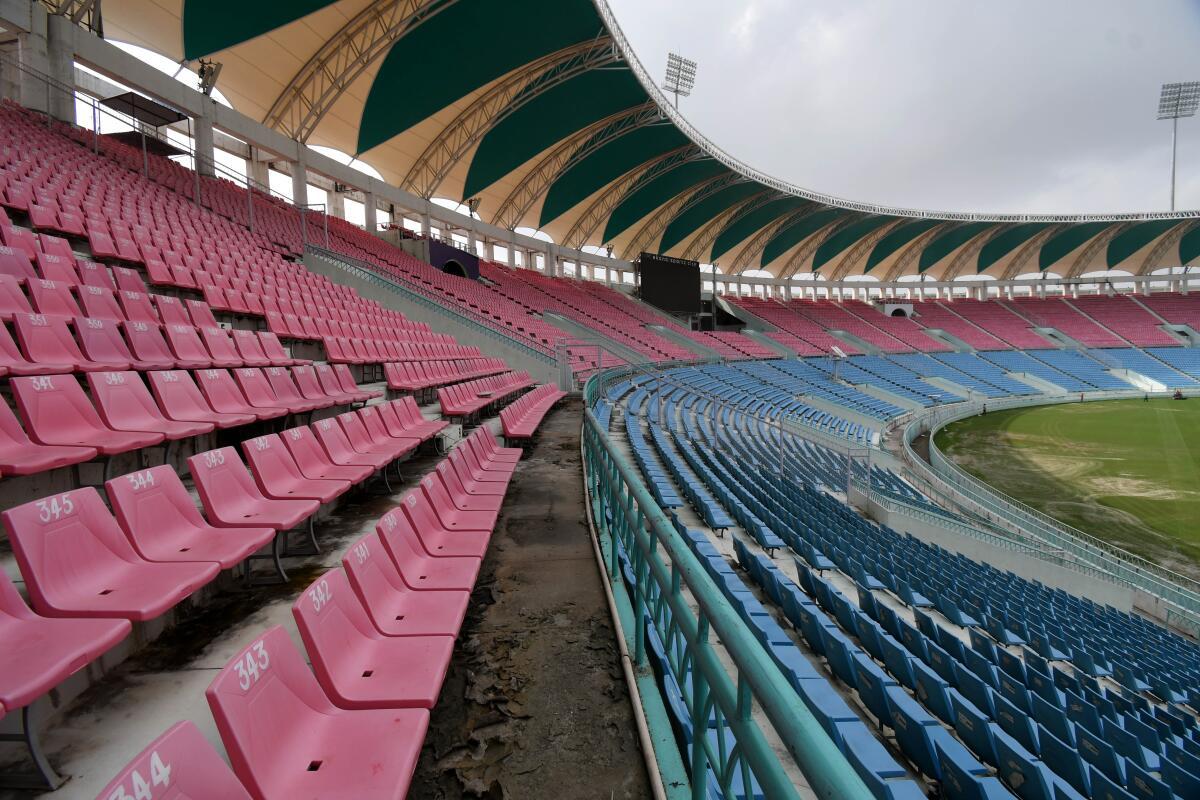
The stands at the Ekana Stadium are well ventilated and pillar-free. Nothing blocks spectator view of the pitch.
| Photo Credit:
SANDEEP SAXENA
The stands at the Ekana Stadium are well ventilated and pillar-free. Nothing blocks spectator view of the pitch.
| Photo Credit:
SANDEEP SAXENA
Capacity: The Ekana Stadium has a capacity of approximately 50,000 spectators. The general stands on the east and west ends hold 44,296 seats, while the rest are allocated to hospitality areas in the north and south ends. Among these, 2,716 seats are reserved for closed hospitality areas, and about 3,390 seats are designated for semi-hospitality (open President’s Stand) areas. Importantly, there are no pillars or sight screens, ensuring an unobstructed view for all spectators at Ekana.
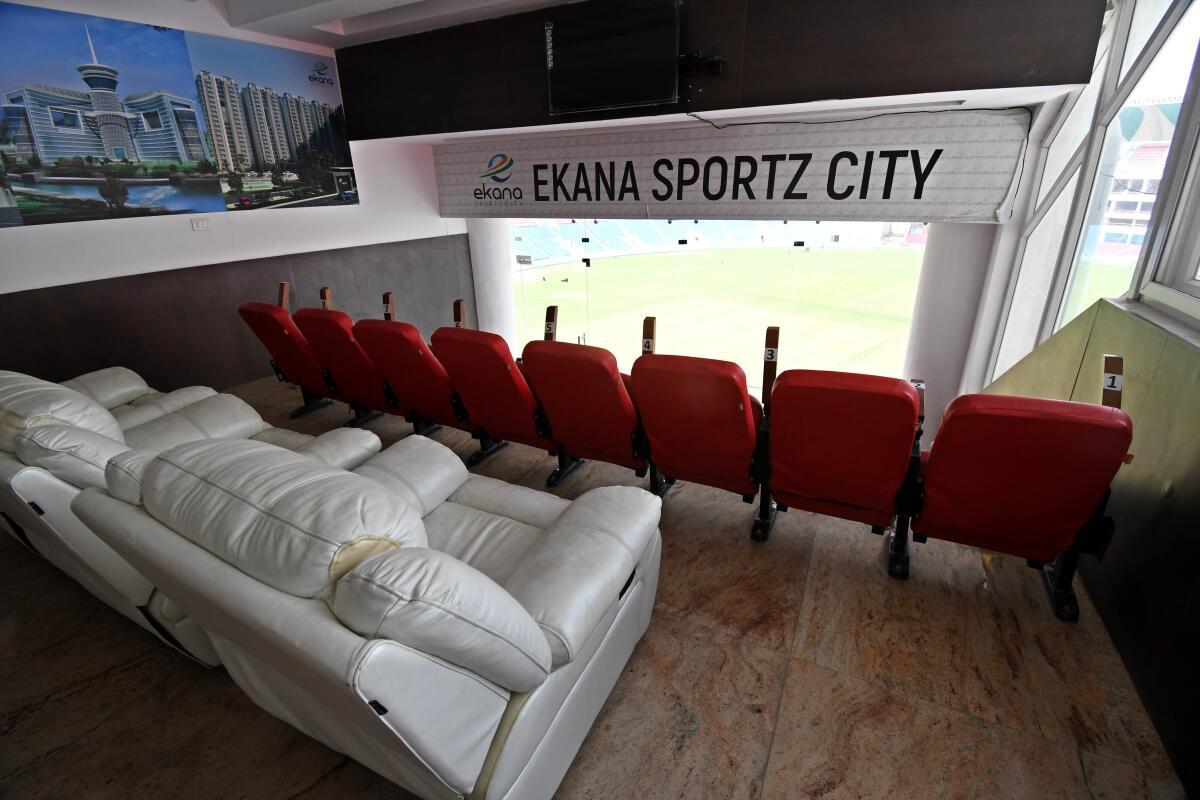
A view of one of the hospitality boxes at the Ekana Stadium. Every space comes equipped with a washroom-shower for guests.
| Photo Credit:
SANDEEP SAXENA
A view of one of the hospitality boxes at the Ekana Stadium. Every space comes equipped with a washroom-shower for guests.
| Photo Credit:
SANDEEP SAXENA
Hospitality boxes: There are 32 hospitality boxes, 16 at each end. While seat distribution varies, each box is equipped with its own washroom and shower. Additionally, there are four VVIP areas, typically hosting the city’s political figures, with their own dining spaces. These areas are reserved for esteemed guests and dignitaries. In terms of seat allocation, the BCCI has reserved 200 seats, the International Cricket Council 250 seats, participating teams 40 seats, and the UPCA 400 seats, as per a tentative seating arrangement accessed by Sportstar.
WiFi will be available to players and select guests. Three levels in the North and South Ends can be accessed by stairs and elevators on either side. There will be a separate entrance and stairway for participating teams to safeguard their privacy and safety.
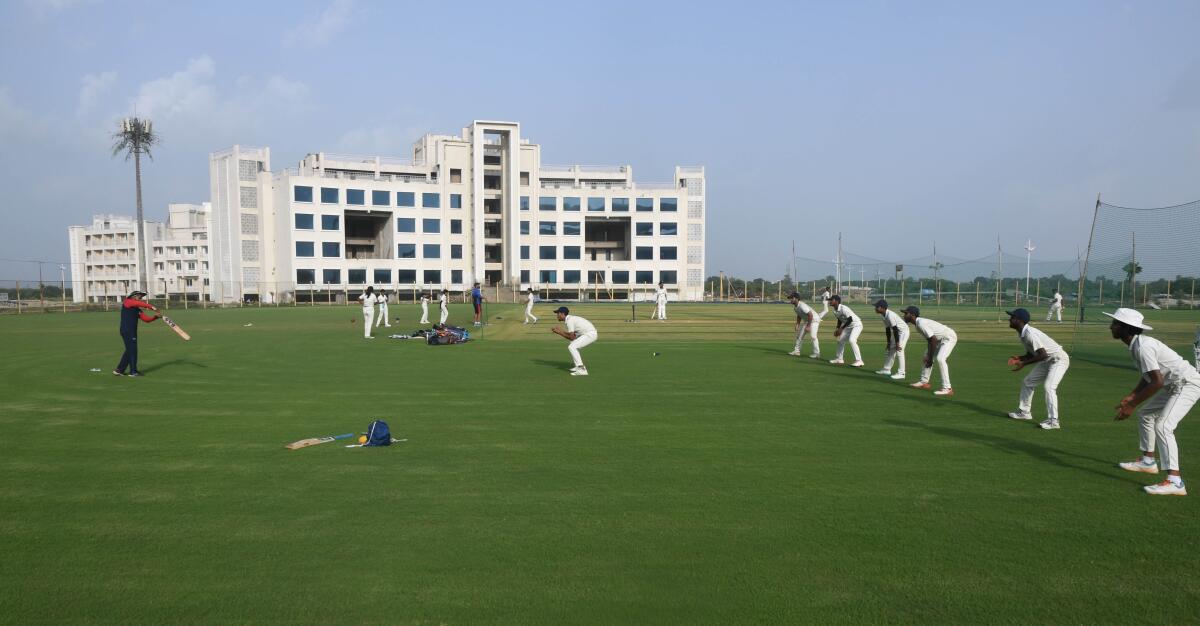
The B Ground outside the Ekana main stadium premises. This space has 19 pitches with the same black and red combination the stadium uses. This space will soon have floodlight provision too.
| Photo Credit:
SANDEEP SAXENA
The B Ground outside the Ekana main stadium premises. This space has 19 pitches with the same black and red combination the stadium uses. This space will soon have floodlight provision too.
| Photo Credit:
SANDEEP SAXENA
Floodlights: The stadium has six halogen floodlight towers, which need 30 minutes to come on completely.
Practice facilities: Adjacent to the Ekana Stadium is a B ground with 19 pitches and net facilities, utilised for cricket coaching camps, academy matches, and club games. LSG prioritises this space for its preparations. However, there are no indoor nets or practice areas available on-site.
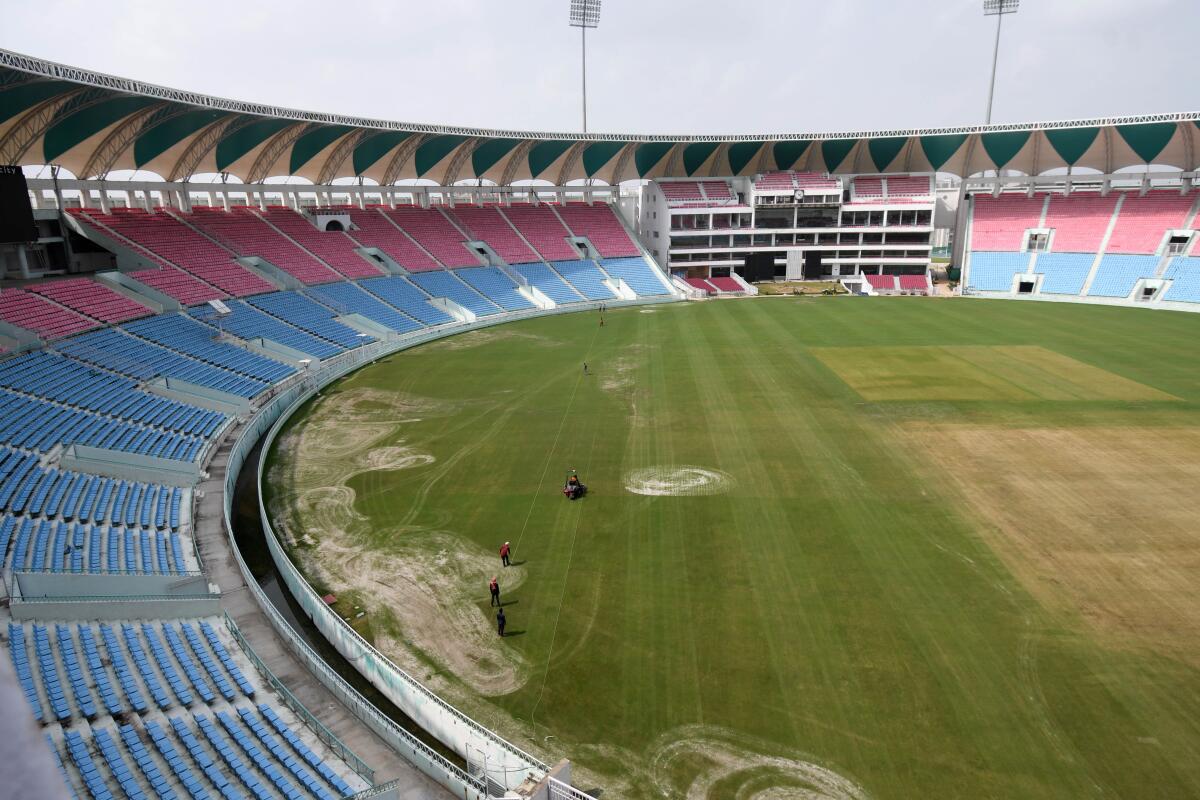
The square patch in the centre of the pitch shows the work gone into redoing the wickets at the Ekana. The focus from now till the start of the World Cup will be grow and maintain good grass cover throughout the playing area. Manicuring of the grass and beautification (the patterned lines being mowed in) has begun too.
| Photo Credit:
SANDEEP SAXENA
The square patch in the centre of the pitch shows the work gone into redoing the wickets at the Ekana. The focus from now till the start of the World Cup will be grow and maintain good grass cover throughout the playing area. Manicuring of the grass and beautification (the patterned lines being mowed in) has begun too.
| Photo Credit:
SANDEEP SAXENA
Pitches: The Ekana Stadium pitch drew scrutiny when Hardik Pandya criticised it as a ‘shocker’ following a low-scoring T20I against New Zealand. Subsequently, the curator, Surendra Yadav, was replaced by Sanjeev Agarwal. After the 2023 IPL season, the pitch underwent extensive renovation.
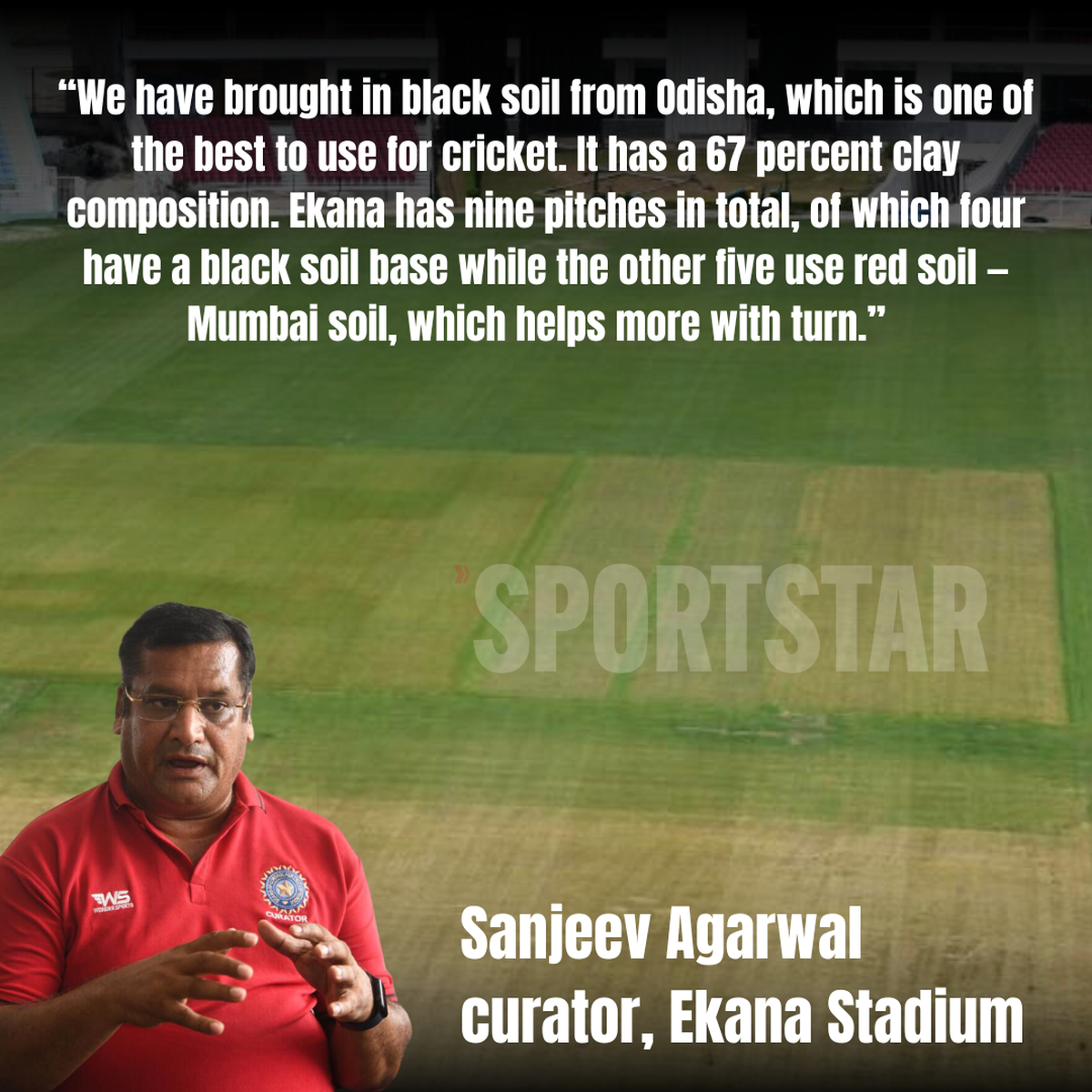
Pictures of the entire centre being dug up circulated on social media, revealing salt accumulation. Agarwal utilised terreplex, a safe acid, to modify soil pH and dissolve calcified deposits over a 14-day period. The pitch consists of three layers: a base of coarse soil, an intermediate layer, and an eight-inch top layer of cricketing soil, with some venues opting for clay while others use sand.
There is a herringbone drainage system at Ekana, resembling the bones of a herring fish, which includes a central sloping pipe with lateral pipes to efficiently manage water.
| Photo Credit:
SANDEEP SAXENA
There is a herringbone drainage system at Ekana, resembling the bones of a herring fish, which includes a central sloping pipe with lateral pipes to efficiently manage water.
| Photo Credit:
SANDEEP SAXENA
Drainage and outfield: There is a herringbone drainage system, resembling the bones of a herring fish, which includes a central sloping pipe with lateral pipes to efficiently manage water. This design allows for match resumption within 30 minutes after the rain stops. Additionally, the system collects rainwater in a moat around the outfield for reuse.
Entry points: There are five main entrance gates and 25 entry points to the stands. Gate No. 3 is typically reserved for players and VIPs. A peripheral road encircles the main venue, facilitating easy car and bus access, a rarity among Indian stadiums. However, crowd control will be crucial on busy match days to ensure the passageway remains usable for vehicles. Five hundred parking slots for two-wheelers and four-wheelers are available in multiple areas.
Although Lucknow lacks metro access to the stadium, buses run to Amar Shaheed Path, the main connecting road. E-rickshaws and shuttle services are also considered for fan mobility on match days. An issue reporters faced during the IPL was delays at security checks as those in the Sportz City would also access the facilities through the same entrances. Security for the World Cup will be more adept and experienced in experiencing this, and arrangements are also expected to facilitate the smooth entry and exit of fans.
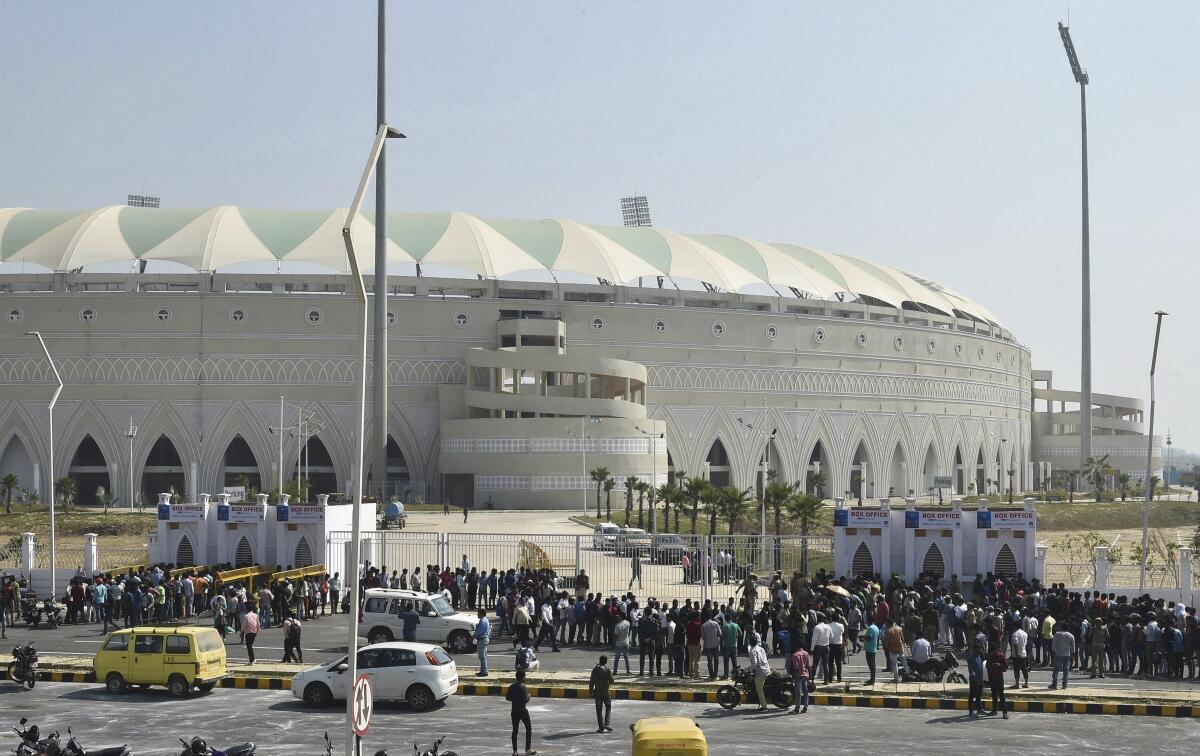
A view of the box office at the Ekana Stadium before a T20I fixture in 2018
| Photo Credit:
Rajeev Bhatt
A view of the box office at the Ekana Stadium before a T20I fixture in 2018
| Photo Credit:
Rajeev Bhatt
“Metro access to Ekana is being planned in the second phase here in Lucknow. We’ve been mulling a 45m road around the stadium dedicatedly, which might help us sort out the congestion here on matchdays. As of now, we have only Amar Shaheed Path, the main roadway in the area, but hopefully this road will help us out. The government’s support will be crucial in helping us deal with these aspects of match experience,” Sinha says.
Accessibility and challenges: There are good facilities for wheelchair-bound spectators, including spacious walkways in the stands and seats at stair levels with wheelchair access in every block. Six spiral ramps around the stadium ensure easy access to the stands. The venue prioritises accessibility for fans with varying abilities, and the organisers are considering providing wheelchairs on campus if necessary. However, ramps are not available within the stands for movement between seating floors, limiting wheelchair-accessible seating to that specific floor level.

There are six circular ramps all around the stadium – as many as there as floodlights at this stadium. These ramps provide access to different levels of seating blocks for those who use wheelchairs and to aid emergency services should the need arise.
There are six circular ramps all around the stadium – as many as there as floodlights at this stadium. These ramps provide access to different levels of seating blocks for those who use wheelchairs and to aid emergency services should the need arise.
In case of emergency: There will be six medical kiosks. Four ambulances will be on standby at the premises, with two dedicated to players, one each for the home and away team.
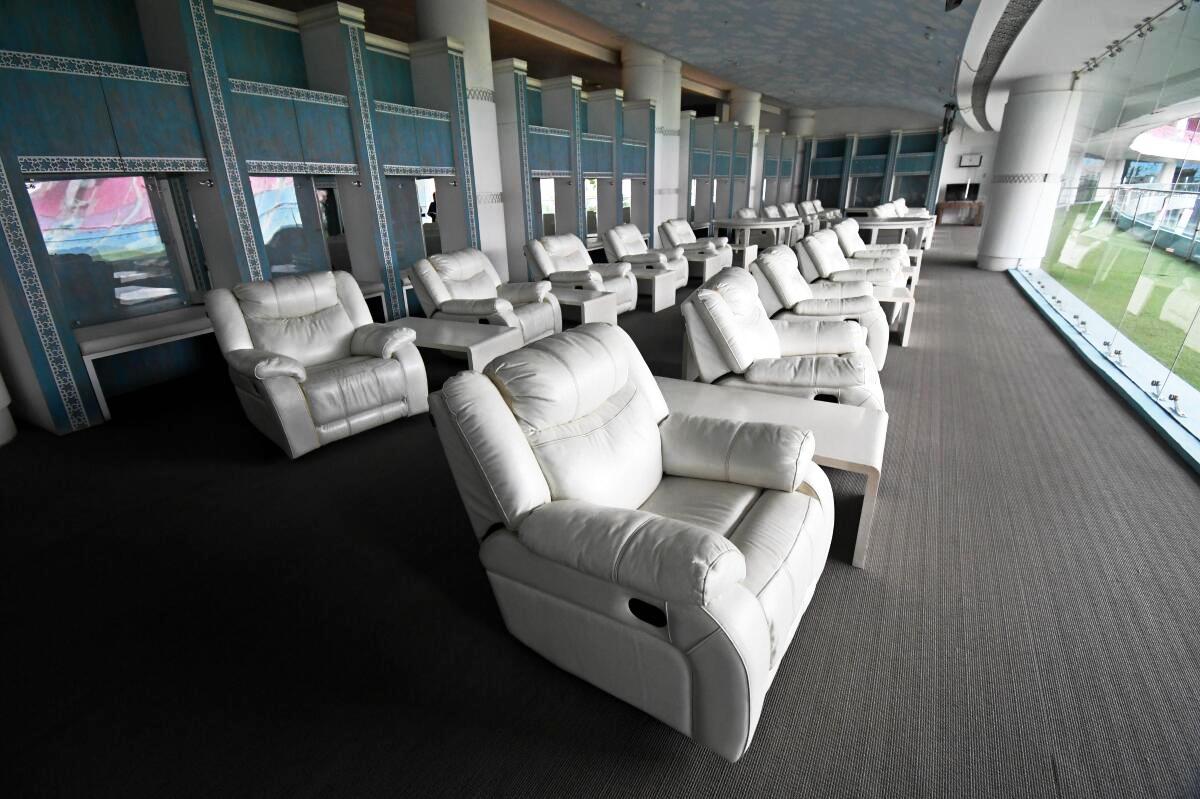
The Ekana Stadium has two dressing rooms – one for each participating team. These spaces have a balcony area for the technical teams’ benefit and their own entries from the outer periphery and a stairwell leading to the main pitch to ensure privacy and safety of the players.
The Ekana Stadium has two dressing rooms – one for each participating team. These spaces have a balcony area for the technical teams’ benefit and their own entries from the outer periphery and a stairwell leading to the main pitch to ensure privacy and safety of the players.
Dressing rooms: There are two spacious dressing rooms in the South End, painted in a blue-ivory-white colour scheme. They offer identical facilities for both home and away teams, including player sofas, individual slots with storage and lockers, and a viewing gallery for support staff. Connected to the dressing rooms is a large dining area, with passageways leading to saunas, ice baths, and jacuzzi rooms for player warm-up and recovery. A common gym is centrally located between the dressing rooms, and washrooms and showers are readily accessible.
Washrooms: Every block offers accessible washroom facilities for men, women, and the differently abled. These spacious washrooms feature over 15 cubicles, multiple urinals, good ventilation, and convenient proximity to stand entrances. Dedicated washrooms for the differently abled include support handles and safe flooring, with accessible wash basins, although height could be a concern for some users.
Water: Drinking water fountains are found in the common area of every block. The BCCI plans to tie up with the official ‘pouring partner’ of the tournament to provide free drinking water for all the spectators.
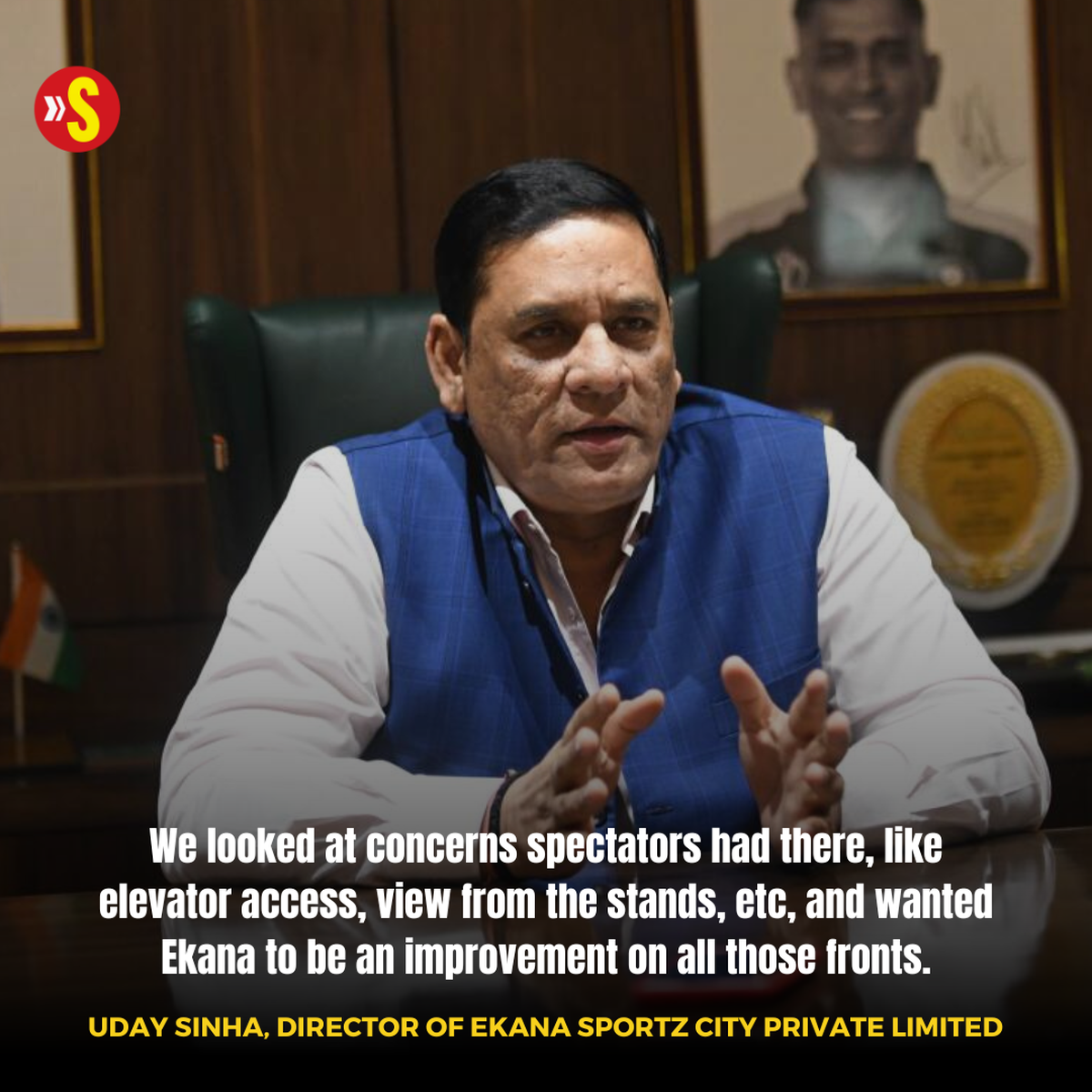
Elevator access: The East and West stands which constitute the main spectator areas do not have elevator access, but there are spacious ramps available, ensuring no cumbersome staircases for spectators to climb to get to their seats. The North and South End, which has the player areas, broadcaster spaces, media boxes and hospitality arenas have elevator access.
Renewable energy: At the moment, Ekana does not use renewable energy. The stadium has generator backup to ensure there are no stoppages in play or broadcast due to electricity failure. “Renewable energy like solar panels are concepts we’ve earmarked to explore in the future given the space we have here in the stadium campus,” Ankit Chatterjee, CEO of UPCA, said.
The ground itself, however, uses harvesting mechanisms to maximise the use of rainwater in the upkeep of the premises and to direct back to the RO water facility set up here in the maintenance of the pitch.
The ICC World Cup is expecting a massive inflow of journalists from around the world, which the organisers here need to work on accommodating.
| Photo Credit:
SANDEEP SAXENA
The ICC World Cup is expecting a massive inflow of journalists from around the world, which the organisers here need to work on accommodating.
| Photo Credit:
SANDEEP SAXENA
Areas that need attention
# The media box in the Ekana Stadium has a capacity of 60. The ICC World Cup is expecting a massive inflow of journalists from around the world, which the organisers here need to work on accommodating.
# Ground staff and locals say that rainfall in Lucknow has been less than optimal so far, with worries about rain interruptions during the World Cup. Provisions for indoor nets and training spaces should be one addition to the preparations ahead of the tournament.
# To address spectators’ concerns, particularly those driving from the city, the UPCA is collaborating with security agencies to streamline parking and the walk to the main stadium, with a focus on ensuring organised entry and exit, especially during India’s scheduled match.
